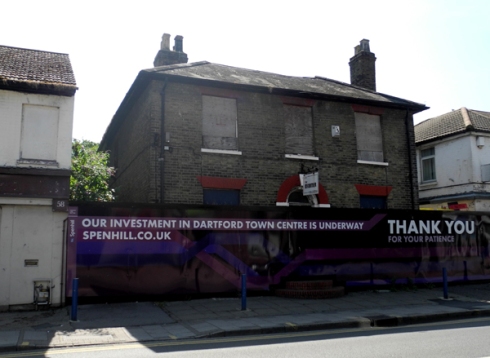You are currently browsing the monthly archive for January 2015.
It seems that Kidbrooke has been a building site for over sixty years. Following the Second World War the marshy farmland of Kidbrooke was the site of a massive house building programme. The first phase of which was aimed at the well off as a three bedroom semi cost £2,750. In the same period a five bedroom period property in Ulundi Road Blackheath cost £1650. There’s nothing so fickle as taste and the same properties today sell at £465,000 and £1.2 million respectively. Social Housing was provided at The Ferrier Estate but this came later in the 1960s. It has since been demolished to make way for the Kidbrooke Village development with apartments starting at £300k, so not that affordable.
Today you can alight at Kidbrooke Station and enter the swish surroundings of Berkeley Homes Marketing Suite. Back in 1953 the Estate Agents was still found close to the station but a rather more modest affair.
In the midst of the 1950s estate the London County Council built the first purpose built comprehensive school which opened in 1954 some ten years before the national system. It was one of the few “experimental” comprehensive schools opened in largely Labour controlled authorities. By 1958 there were only 46 such schools nationally. The 50s/60s were the belle epoch of British social mobility and popular opinion was behind the comprehensive system. The grammar school system was seen as devisive and as they only educated 4% of the population did not provide enough places to meet the requirements of the expanding middle classes. The comprehensive was expected to have great appeal and a new bus route, the number 70, from Victoria to Eltham, operating four buses an hour, was introduced so that children outside the neighbourhood could enrol at the school.
Sixty years on and social mobility has seized up, there is a widening gap between the richest and poorest. In attempts to fix the system some look to change the structures of schools introducing unaccountable Academies. The local Conservative candidate for the area wants to bring back grammar schools. It cannot be denied that in the post war period the grammar schools churned out thousands of elevated working class kids but the economy had the salaried jobs for them. Today, we have record numbers in low paid jobs and the threat of 10 million jobs being made redundant by digital technologies so focussing on the school system alone looks rather futile.
In July last year I wrote this post posing the question, “Is the decline terminal?”. Today, sadly we found out that it is. After dithering for 11 years and demolishing a handsome parade of period shops Tesco announced that they are pulling out of their proposal to develop a new store and housing on the Lowfield site. Historic Dartford is left as a wasteland. Tesco also announced plans to close 43 unprofitable stores across the UK, although the locations of these have not yet been revealed. We wait and see what is to happen upstream at Woolwich.
Dartford may well thrive again but a walk through the historic market town leaves the distinct impression that the decline is terminal. Arriving by train one of the first sights is the abandoned Waitrose supermarket, continue through the Orchard shopping centre where there appears to be more vacant than occupied shop units. It’s a ghost town with little footfall to boost sales for those shops still clinging on.
Lowfield Street is awaiting demolition. Notices on the hoardings all along the street proclaim to residents and visitors that “it’s been worth the wait” and “not long to wait”.
Well the townspeople of Dartford have been waiting eleven years for this planning scheme to come to fruition. A new Tesco is coming to town bringing jobs and affordable homes. It’s good to know that there will be new jobs for the many retail staff who have recently lost their jobs, but is this a net gain?
Most historic market towns celebrate their heritage and try to preserve their fine buildings. Now, not all market towns can be preserved in aspic like Stamford in Lincolnshire but most find a way of balancing new development with the old. The buddleia growing out of the decorative brickwork of the remaining heritage buildings doesn’t fill you with confidence about their preservation.
Can Tesco regenerate the town? At the turn of the millenium that may have looked like a possiblity but since then Tesco has been losing market share, austerity kicked in and people have changed their shopping habits. Architecturally it will do nothing to make the place worth visiting. Its neighbour upstream at Woolwich has been shortlisted for the carbuncle prize. The former chair of Planning at the Royal Borough of Greenwich, Alex Grant, has stated that it’s a flawed project; a blight on the regeneration of the town and he regrets his role in its progeny. Oh dear it doesn’t bode well for Dartford.








